Having exceeded expectations by making it through to the last eight by topping a group featuring Saudi Arabia, Uzbekistan and North Korea, China now face the unenviable task of taking on host nation Australia for a place in the semi-finals. Here, we take an in-depth look at the Antipodeans and assess China’s prospects of continued progress in the competition.
Major Tournament History
Prior to moving to the Asian Football Confederation in 2006, Australia played their continental football tournaments in Oceania where they are four times OFC Nations Cup winners. However, such results as a 17-0 win over the Cook Islands in 2000 and an 11-1 aggregate win over the Solomon Islands in the 2004 final not only demonstrate why this shouldn’t be considered a major tournament, but also why the Socceroos were in such desperate need to link up with their Asian cousins in order to get more competitive football.
In 2007, their first attempt at becoming champions of the world’s largest continent ended in disappointment with a group stage loss to Iraq followed by a quarter-final elimination at the hands of Japan. Things went much better four years later in Qatar when the Socceroos destroyed Uzbekistan 6-0 on their way to final, only to once again succumb to the Samurai Blue.
On the global stage, the Aussie’s first taste of World Cup action came during the 1974 competition in West Germany. Fielding a largely amateur team, it was not much of a shock that they made the long trip home after the group stage without a single goal to show for their efforts. By the time of their next qualification, 32 years later, the side was fully professional and fared much better in a reunified Germany.
A win over Japan and draw with Croatia was enough to put the Australians through to the second round of the World Cup for the only time in their history and, once there, they lost 1-0 to eventual champions, Italy, courtesy of a hugely controversial 93rd minute penalty. That was their last World Cup as a representative of Oceania, and they are now two for two in their Asian qualifying campaigns, although both have led to first round eliminations at the tournament proper.
How They Made It To Australia
Unsurprisingly, it wasn’t difficult for Australia to make it to Australia. Their qualification was assured when they were awarded hosting duties back on January 5th 2011. Interestingly, courtesy of the AFC’s rule that the top three teams in the 2011 tournament automatically qualify for the 2015 edition, the Aussies also qualified later that month when they made it to the final of the tournament in Qatar .
What’s interesting about that you say? Because of Australia’s double entry, the AFC had to find another team from somewhere, meaning that the best third-placed side from one of the five qualification groups would also make the tournament. Which team scraped into the competition thanks to that additional place? Why, China, of course.
Recent Form and News
Current Head Coach Ange Postecoglou was appointed in October 2013 with the task of regenerating a side whose “golden generation” had largely outstayed their welcome. A 1-0 win over Costa Rica a month later gave cause for optimism, but Postecoglou’s men won just a solitary game in 2014, while drawing two and losing eight. To be fair, three of those defeats came in a World Cup “group of death” featuring Spain, Holland and Chile, and the Australians received plaudits for their battling performances against superior opposition.
Their Asian Cup So Far…
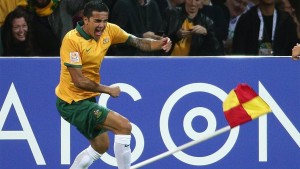
No Signs Of Falgging:Tim Cahill celebrates a goal against Kuwait with his customary pounding of the corner flag
Plucky efforts aside, such a run of form was hardly ideal preparation for a home tournament. However, those results were largely forgotten when the Australians swept away Kuwait in the tournament opener at the very pragmatically named Melbourne Rectangular Stadium. The hosts found themselves 1-0 down after eight minutes , but goals from Tim Cahill, Mass Luongo, Mile Jedinak and James Troisi gave the Aussies a 4-1 win and highlighted an impressive attacking display which overwhelmed the Kuwaitis.
The momentum continued into the second group game when it was Oman’s turn to concede four goals, only this time without reply. Matt McKay, Robbie Cruse, Mark Milligan and Tomi Juric were the scorers in yet another dominant attacking display which proved far too much for their Middle Eastern opposition.
The final group game was a different story as Postecoglou fielded a much changed team, including a completely new front three, against a South Korea side vastly superior to the previous two opponents. Both teams had already qualified for the quarter-finals by this point, and Australia only had to draw the game in order to proceed as group winners. However, although they probably deserved at least a draw from the game, the Australians were undone by a first half strike from Lee Jung-hyup and a professional Korean performance which illustrated the obvious defensive weaknesses in the Socceroos first two opponents.
Players To Watch
There’s only one person to start with here, and that’s the irrepressible Tim Cahill who, at 35-years-old, continues to terrorise opposing defenses and innocent corner flags in equal measure. Still going strong at the New York Red Bulls, the former Everton and Millwall forward has had a great club career, but has been far more prolific in front of goal with his national team.
Cahill has 37 goals in 78 appearances for the Aussies and his vital role in the side was illustrated throughout 2014 when he was the only player to score from open play – including a memorably spectacular volley against Holland during the World Cup. Australia may have found alternative scoring outlets in the first two games of this tournament, but Cahill’s eye for goal and uncanny knack for scoring headers means that he is undoubtedly the Soceroos’ danger man.
With the possible exception of Cahill, Australia’s most influential player is captain and defensive midfielder Mile Jedinak. For both his club, Crystal Palace, and country Jedinak has been exceptional in recent years at breaking up opposition attacks and quickly recycling the ball. After scoring a penalty, the 30-year-old left the opening game against Kuwait with an ankle injury and missed the subsequent games against Oman and South Korea.
He wasn’t really needed against the former but was sorely missed against the latter and the bad news for China is that he should be back to full fitness in time for their quarter-final encounter. Jedinak’s return will make the Australians that much tougher to break down and his reliability from 12 yards out means his team pretty much have a one goal head start should the match require a penalty shoot-out.
History vs China
The only two times these sides have met in what FIFA recognizes as competitive fixtures was during the qualification campaign for the 2010 World Cup. China actually had the better of those two games when they held the Aussies to a 0-0 draw in Kunming, before defeating them 1-0 on the back of a Sun Xiang strike in Sydney. That sounds like a famous win but, unfortunately, it came in the last game of a group in which Australia had already booked their place in the next round and China had, after a disastorous effort, already been eliminated. Needless to say that the loss meant little to the Australians as they jetted off to South Africa in 2010.
The most recent meeting between the two sides was a competitive one of sorts and also saw the Chinese come out on top. Australia were invited to take part in the EAFF East Asian Cup for the first (and perhaps only) time in 2013 and lost an entertaining game 4-3 in South Korea. Yu Dabao, Yang Xu, Wu Lei and, man of the moment, Sun Ke, all got on the score sheet for China, but there is a major asterisk next to the result.
Due to the timing of the competition, only Asian based players were able to compete, meaning that the Australians were severely weakened while China were basically at full strength. However much stock one puts in past results, they will all pale in comparison to the outcome of this quarter-final which is the most important meeting these two sides have ever had.
Prospects and Predictions
Although China go into this game as group winners with a 100% record in the competition, they are the undisputed underdogs in this contest, and justifiably so. Three wins out of three in the group stages was an historic achievement for Alain Perrin, but none of those opponents were quite of Australia’s caliber. It is apparent from the first two games that Australia offer a greater threat going forward than anyone China have faced so far and the movement of the frontline in the home side’s 4-3-3 is something the Chinese defensive unit will struggle to deal with.
Australia attacked against Kuwait and Oman with devastating effect but, so far in this tournament, China have shown themselves to be much better organized and defensively resolute than their Middle Eastern counterparts. There is little chance of China being torn apart like the Kuwaitis or Omanis were, but it’s also going to be a big ask to keep a clean sheet. Of course, South Korea managed it, but, as well as probably having better players, they also faced a reserve front three minus the likes of Tim Cahill and Robbie Kruse.
If China can’t keep the Aussies out, it’s obviously imperative that they score a couple of their own. Five goals in three group games hasn’t been a bad return for a team that struggled to score against decent opposition throughout 2014 and the sudden arrival of Sun Ke as a goal scorer bodes well for China’s potential tally.
However, a couple of things must be kept in mind. The first is that Yu Hai’s strike against Saudi Arabia was somewhat of a fluke and the second is that both of Sun’s goals against North Korea came courtesy of the kind of generous defending that won’t be donated by the Australians.
With Gao Lin only ever looking like netting at the wrong end, China will need a little more from their creative midfield players. Sun Ke has stepped up, but Wu Lei needs to show more composure around the opposition penalty area and Hao Junmin could do more to create chances himself without having to go through the fullbacks first.
China will also need Wu Xi’s surging runs from deep to help them pressurize the Aussies, although there is some speculation that the starting line-up against North Korea, featuring Cai Huikang in place of Wu, was a dress rehearsal for the quarter-final. If that proves to be the case, then China will lose a lot going forward, while only being slightly better protected by the immobile Cai at the back.
All other considerations aside, Australia’s home field advantage could prove pivotal. In every game China have played so far they have been the de facto home side as a consequence of the large Chinese diaspora Down Under. In this game, that obviously won’t be the case, and it will be interesting to see how the Chinese players cope in a hostile environment. Conversely, the hosts may struggle to deal with the pressure and find it hard to stay composed should they have trouble breaking China down.
This is a tough game to call, and while the heart may say China, the head says the Australians may just have a bit too much for a young team that has already exceeded expectations. If Alain Perrin’s men can stay in the game until the latter part of the second half, they have every chance of getting the win, but that could prove too tough a task against a team roared by a boisterous home crowd.
Prediction – Australia to take it 3-1 (would love to be proven wrong though)

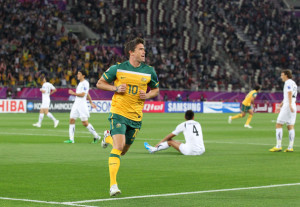

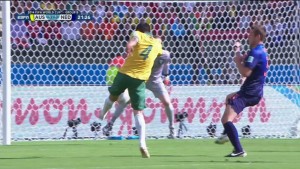
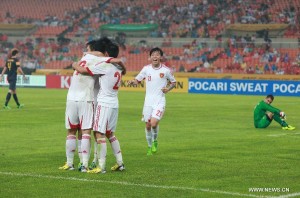
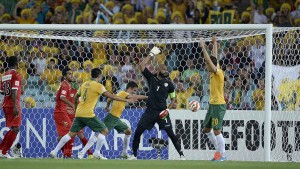
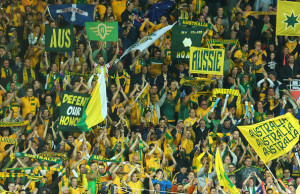
A fair prediction!
I have vague hopes that China can sneak a 1-1 draw after full time…
Mads Davidson has a good preview on his blog as well – key is to contain Oz on the wings and then outpace them on the counter.